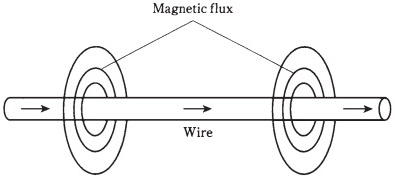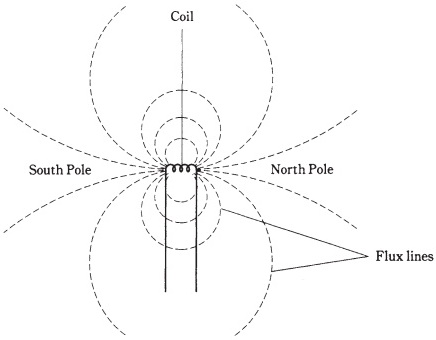Electric currents and magnetic fields are closely related. Whenever an electric current flows - that is, when charge carriers move - a magnetic field accompanies the current. In a straight wire, the magnetic lines of flux surround the wire in circles, with the wire at the center (Fig. 2-11). Actually, these aren't really lines or circles; this is just a convenient way to represent the magnetic field. You might sometimes hear of a certain number of flux lines per unit cross-sectional area, such as 100 lines per square centimeter. This is a relative way of talking about the intensity of the magnetic field.

2-11 Magnetic flux lines around a straight, current-carrying wire. The arrows indicate current flow.
Magnetic fields can be produced when the atoms of certain materials align them#selves. Iron is the most common metal that has this property. The iron in the core of the earth has become aligned to some extent; this is a complex interaction caused by the rotation of our planet and its motion with respect to the magnetic field of the sun. The magnetic field surrounding the earth is responsible for various effects, such as the concentration of charged particles that you see as the aurora borealis just after a solar eruption.

2-12 Magnetic flux lines around a coil of wire. The fines converge at the magnetic poles.
When a wire is coiled up, the resulting magnetic flux takes a shape similar to the flux field surrounding the earth, or the flux field around a bar magnet. Two well-defined magnetic poles develop, as shown in Fig. 2-12.
The intensity of a magnetic field can be greatly increased by placing a special core inside of a coil. The core should be of iron or some other material that can be readily magnetized. Such substances are called ferromagnetic. A core of this kind cannot actually increase the total quantity of magnetism in and around a coil, but it will cause the lines of flux to be much closer together inside the material.
This is the principle by which an electromagnet works. It also makes possible the operation of electrical transformers for utility current. Magnetic lines of flux are said to emerge from the magnetic north pole, and to run inward toward the magnetic south pole. But this is just a semantical thing, about which theoretical physicists might speak. It doesn't need to concern you for ordinary electrical and electronics applications.
Magnetic units
The size of a magnetic field is measured in units called webers, abbreviated Wb. One weber is mathematically equivalent to one volt-second. For weaker magnetic fields, a smaller unit, called the maxwell, is sometimes used. One maxwell is equal to 0.00000001 (one hundred-millionth) of a weber, or 0.01 microvolt-second.
The flux density of a magnetic field is given in terms of webers or maxwells per square meter or per square centimeter. A flux density of one weber per square meter (1 Wb/m2) is called one tesla. One gauss is equal to 0.0001 weber, or one maxwell per square centimeter.
In general, the greater the electric current through a wire, the greater the flux density near the wire. A coiled wire will produce a greater flux density than a single, straight wire. And, the more turns in the coil, the stronger the magnetic field will be.
Sometimes, magnetic field strength is specified in terms of ampere-turns (At). This is actually a unit of magnetomotive force. A one-turn wire loop, carrying 1 A of current, produces a field of 1 At. Doubling the number of turns, or the current, will double the number of ampere-turns. Therefore, if you have 10 A flowing in a 10-turn coil, the magnetomotive force is 10 x 10, or 100 At. Or, if you have 100 mA flowing in a 100-turn coil, the magnetomotive force is 0.1 x 100, or, again, 10 At. (Remember that 100 mA = 0.1 A.)
Another unit of magnetomotive force is the gilbert. This unit is equal to 0.796 At.
About the Author
Stan Gibilisco is one of McGraw-Hill's most prolific and popular authors, specializing in electronics and science topics. His clear, reader-friendly writing style makes his science books accessible to a wide audience, and his background in research makes him an ideal editor for professional references and course materials. He is the author of The Encyclopedia of Electronics; The McGraw-Hill Encyclopedia of Personal Computing; and several titles in the popular Demystified library of home-schooling and self-teaching books. His published works have won numerous awards. The Encyclopedia of Electronics was chosen a "Best Reference Book of the 1980s" by the American Library Association, which also named his McGraw-Hill Encyclopedia of Personal Computing a "Best Reference of 1996." Stan Gibilisco maintains a Web site at www.sciencewriter.net.
Quickly and easily learn the hows and whys behind basic electricity, electronics, and communications - at your own pace, in your own home Teach Yourself Electricity and Electronics, Fourth Edition offers easy-to-follow lessons in electricity and electronics fundamentals and applications from a master teacher, with minimal math, plenty of illustrations and practical examples, and test-yourself questions that make learning go more quickly. Great for preparing for amateur and commercial licensing exams, this trusted guide offers uniquely thorough coverage, ranging from dc and ac concepts and circuits to semiconductors and integrated circuits.
The best course - and source - in basic electronics
• Starts with the basics and takes you through advanced applications such as radiolocation and robotics
• Packed with learning-enhancing features: clear illustrations, practical examples, and hundreds of test questions
• Helps you solve current-voltage-resistance-impedance problems and make power calculations
• Teaches simple circuit concepts and techniques for optimizing system efficiency
• Explains the theory behind advanced audio systems and amplifiers for live music
• Referenced by thousands of students and professionals
• Written by an author whose name is synonymous with clarity and practical sense
New to This Edition: Updated to reflect the latest technological advances in:
• Wireless technology
• Computers and the Internet
• Transducers
• Sensors
• Robotics
• Audio systems
• Navigation
• Radiolocation
• Integrated circuits
ReaderRobert L. Young says; "I'm doing course development for a community college. I have evaluated a number of books in order to select one to use as the textbook. The course title is "Basic Electronics and Troubleshooting." This is the book I selected for the course. It has all of the material needed for the course requirements. It has good, understandable illustrations. It includes end of chapter quizzes with answers in the back. The book has far more material than we will be covering in the class, and includes more advanced math than the students will need for this particular course, but I don't see that as a disadvantage. I'll give them reading assignments relevant to the course work, and let them know that the book contains a lot of valuable, additional information for more advanced study. When I say "more advanced study," don't get me wrong; this book isn't a text for a graduate engineering course. It does, however, contain substantially more information than can be covered in a 72 hour Basic Electronics class. All the basics are well-covered and understandable, and the book allows you to keep moving forward from there."



